The Automotive Night Vision Sensors Market is estimated to be valued at USD 3.5 billion in 2025 and is projected to reach USD 10.2 billion by 2035, registering a compound annual growth rate (CAGR) of 11.4% over the forecast period.
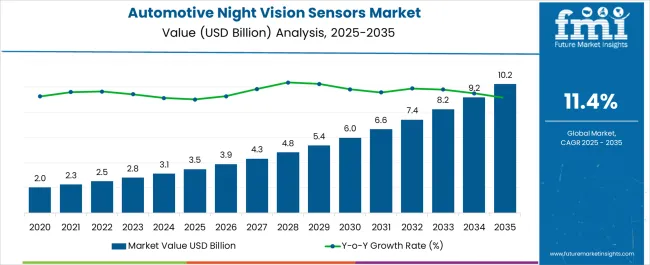
| Metric | Value |
|---|---|
| Automotive Night Vision Sensors Market Estimated Value in (2025 E) | USD 3.5 billion |
| Automotive Night Vision Sensors Market Forecast Value in (2035 F) | USD 10.2 billion |
| Forecast CAGR (2025 to 2035) | 11.4% |
The Automotive Night Vision Sensors market is experiencing steady growth, driven by the increasing integration of advanced driver assistance technologies into modern vehicles. The market has been supported by the rising emphasis on road safety, where improved visibility during low light conditions has become a critical requirement for both regulators and consumers. Advancements in sensor technology, such as thermal imaging and infrared sensing, have enhanced detection accuracy, making these systems increasingly reliable and appealing to automakers.
Growing consumer demand for premium safety features is encouraging widespread adoption, particularly as these systems are increasingly included in mid-range vehicles, not just luxury models. Original equipment manufacturers are actively focusing on offering safety features that differentiate their models in highly competitive markets.
Future growth opportunities are expected to emerge from regulatory encouragement for advanced safety technologies, increasing affordability through economies of scale, and growing demand in regions with challenging night-time driving conditions As road safety continues to remain a global priority, night vision sensors are expected to become a standard feature across vehicle categories in the coming years.
The automotive night vision sensors market is segmented by sales channel, system type, vehicle type, and geographic regions. By sales channel, automotive night vision sensors market is divided into Original Equipment Manufacturer (OEM) and Aftermarket. In terms of system type, automotive night vision sensors market is classified into Passive systems and Active systems. Based on vehicle type, automotive night vision sensors market is segmented into Passenger cars, Compact, Mid-Size, Luxury, Premium, SUV, Light Commercial Vehicles(LCV), and Heavy Commercial Vehicles(HCV). Regionally, the automotive night vision sensors industry is classified into North America, Latin America, Western Europe, Eastern Europe, Balkan & Baltic Countries, Russia & Belarus, Central Asia, East Asia, South Asia & Pacific, and the Middle East & Africa.
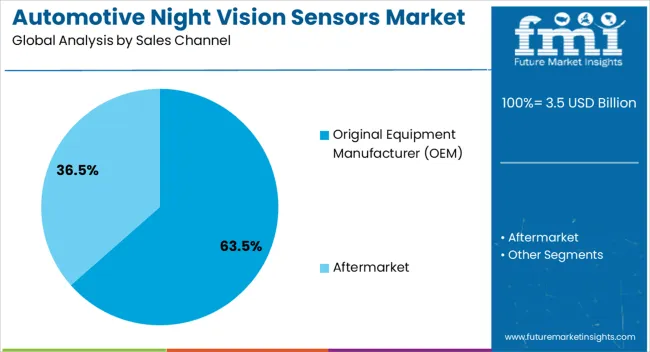
The Original Equipment Manufacturer sales channel is projected to account for 63.50% of the Automotive Night Vision Sensors market revenue in 2025, making it the dominant distribution channel. This leadership is being attributed to the strong influence of vehicle manufacturers in integrating advanced safety systems directly into production lines, ensuring better reliability, performance, and compliance with industry standards. Automakers have increasingly prioritized the integration of night vision sensors as part of broader safety and driver assistance packages, which has encouraged faster adoption.
The inclusion of these systems at the production stage also provides end users with cost advantages compared to aftermarket installations, thereby improving accessibility. The expansion of connected and autonomous vehicle programs has further pushed manufacturers to embed advanced sensing capabilities into new models.
Rising consumer expectations for safety and premium features, coupled with regulatory initiatives promoting advanced driver assistance systems, have reinforced OEMs as the primary channel of distribution This dominance is expected to continue as the industry moves toward higher levels of automation and enhanced safety requirements across global automotive markets.
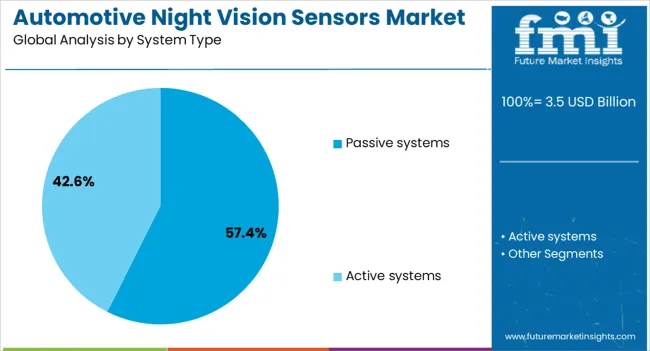
The Passive Systems category is expected to hold 57.40% of the Automotive Night Vision Sensors market revenue in 2025, establishing it as the leading system type. This segment has gained prominence due to its ability to provide effective performance without the need for active infrared illumination, thereby offering a cost advantage and simpler integration within vehicle architectures. Passive systems utilize thermal imaging technologies that are highly effective in detecting pedestrians, animals, and obstacles under low light conditions.
Their reliability in extreme weather conditions has further supported adoption, making them favorable for mass deployment by automakers seeking to balance safety features with cost efficiency. The wider use of these systems in passenger cars, where affordability and efficiency are critical, has also fueled demand.
As night-time accidents remain a major contributor to global road fatalities, passive systems have been increasingly valued for their role in mitigating risks Future growth in this segment is anticipated as ongoing improvements in thermal imaging sensors and processing software deliver better resolution, faster detection speeds, and enhanced accuracy.
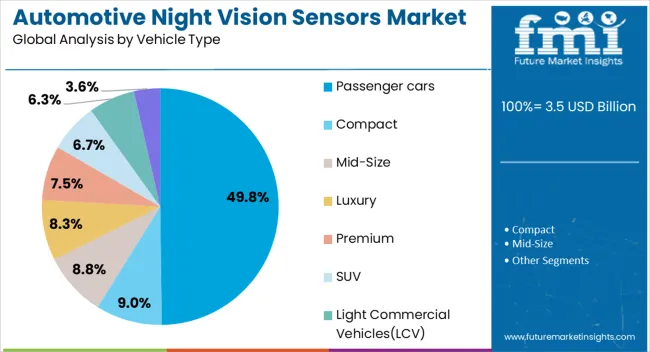
The Passenger Cars category is anticipated to command 49.80% of the Automotive Night Vision Sensors market revenue in 2025, positioning it as the leading vehicle type for adoption. This leadership is being driven by the higher volume of passenger car production worldwide and the growing consumer demand for advanced driver assistance features in personal vehicles. Night vision sensors are increasingly being integrated into mid-segment cars, expanding their adoption beyond luxury vehicles and making the technology accessible to a larger consumer base.
The segment has been further strengthened by rising concerns regarding passenger safety and the growing regulatory emphasis on accident prevention technologies. The inclusion of night vision capabilities adds significant value to consumer perception of vehicle safety, particularly in markets with high instances of night-time driving.
Expanding urbanization, increasing disposable incomes, and heightened safety awareness are pushing manufacturers to include these sensors as part of premium safety packages Passenger cars are expected to remain the dominant end-use category, supported by consistent production growth and evolving consumer expectations for enhanced in-vehicle safety features.
Automotive Night Vision Sensors play a crucial role while driving in the shady or dark (night). Automotive Night Vision Sensors assist and improve the perception and vision range of drivers and passengers during night driving. These Automotive Night Vision Sensors are used in the night vision devices or systems, which generally signifies electronically enhanced optical devices or system which operate in three modes: thermal imaging, image enhancement, and active illumination.
Automotive Night Vision Sensors system basically extend the view of the driver further than the reach of the headlights, through the use of heads-up displays, infrared lights, thermographic cameras and other technologies. Since Automotive Night Vision Sensors system assist and aware drivers to the existence of probable risks, before they become visible, these systems can help prevent mishaps.
The main factor behind the growth of the Automotive Night Vision Sensors market is the rising demand for ADAS from end-users which may be owing to the ongoing trend of using the latest technology. The Automotive Night Vision Sensors manufacture in the automotive industry are actively involved in the continuous development of the night vision sensors system to increase its range and effectiveness which is also expected to support the growth of the Automotive Night Vision Sensors market over the forecast period.
Also, raising awareness among the population about the key safety features of the Automotive Night Vision Sensors is also a factor expected to encourage Automotive Night Vision Sensors adoption globally. Apart from this, Automotive Night Vision Sensors have become an integral part for all premium class vehicle in many countries across the globe so the increase in demand for premium vehicles will also add up to the growth of the global Automotive Night Vision Sensors market.
However, the high cost of advanced technology such as Automotive Night Vision Sensors system and low awareness is anticipated to restrain the growth of the global Automotive Night Vision Sensors market. However, the current trend to use new and better technology for better results will increase the demand for global Automotive Night Vision Sensors market over the forecast period.
Europe, followed by North America holds a significant share in the global Automotive Night Vision Sensors market, owing to the presence of prominent original equipment manufacturer (OEM) of the automobile in the region. The market of Automotive Night Vision Sensors in Europe and North America will have a higher installation rate owing to higher demand for premium and luxury cars, car accessories and car modifications, while this may not be the case in Asia Pacific region, as customers in the Asia Pacific market usually opt for low-end cars with basic features.
Nevertheless, the Automotive Night Vision Sensors market perspective in the Asia Pacific region is expected to grow at a slower pace in the first half of the forecast period eventually grow significantly after that. The Automotive Night Vision Sensors market in MEA regions will depend on the performance and adoption of Automotive Night Vision Sensors. Rest of the world is estimated to account for a relatively small share of the Automotive Night Vision Sensors market.
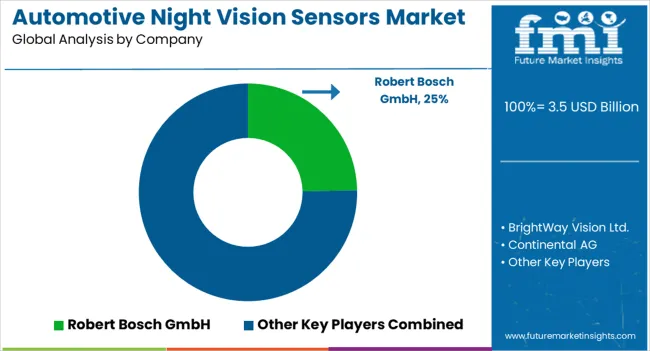
Some of the examples of the market participants operating across the value chain of the global Automotive Night Vision Sensors market are:
The research report presents a comprehensive assessment of the market and contains thoughtful insights, facts, historical data, and statistically supported and industry-validated market data. It also contains projections using a suitable set of assumptions and methodologies. The research report provides analysis and information according to market segments such as geographies, application, and industry.
The report is a compilation of first-hand information, qualitative and quantitative assessment by industry analysts, inputs from industry experts and industry participants across the value chain. The report provides in-depth analysis of parent market trends, macro-economic indicators and governing factors along with market attractiveness as per segments. The report also maps the qualitative impact of various market factors on market segments and geographies.
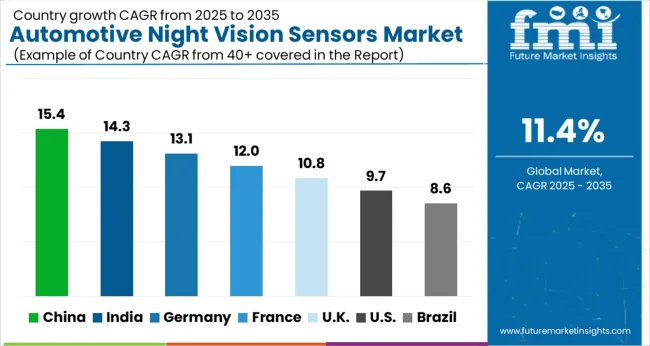
| Country | CAGR |
|---|---|
| China | 15.4% |
| India | 14.3% |
| Germany | 13.1% |
| France | 12.0% |
| UK | 10.8% |
| USA | 9.7% |
| Brazil | 8.6% |
The Automotive Night Vision Sensors Market is expected to register a CAGR of 11.4% during the forecast period, exhibiting varied country level momentum. China leads with the highest CAGR of 15.4%, followed by India at 14.3%. Developed markets such as Germany, France, and the UK continue to expand steadily, while the USA is likely to grow at consistent rates. Brazil posts the lowest CAGR at 8.6%, yet still underscores a broadly positive trajectory for the global Automotive Night Vision Sensors Market. In 2024, Germany held a dominant revenue in the Western Europe market and is expected to grow with a CAGR of 13.1%. The USA Automotive Night Vision Sensors Market is estimated to be valued at USD 1.3 billion in 2025 and is anticipated to reach a valuation of USD 3.3 billion by 2035. Sales are projected to rise at a CAGR of 9.7% over the forecast period between 2025 and 2035. While Japan and South Korea markets are estimated to be valued at USD 156.4 million and USD 101.6 million respectively in 2025.
| Item | Value |
|---|---|
| Quantitative Units | USD 3.5 Billion |
| Sales Channel | Original Equipment Manufacturer (OEM) and Aftermarket |
| System Type | Passive systems and Active systems |
| Vehicle Type | Passenger cars, Compact, Mid-Size, Luxury, Premium, SUV, Light Commercial Vehicles(LCV), and Heavy Commercial Vehicles(HCV) |
| Regions Covered | North America, Europe, Asia-Pacific, Latin America, Middle East & Africa |
| Country Covered | United States, Canada, Germany, France, United Kingdom, China, Japan, India, Brazil, South Africa |
| Key Companies Profiled | Robert Bosch GmbH, BrightWay Vision Ltd., Continental AG, Hella KGaA Hueck & Co., Denso Corporation, Autoliv, Inc., Aisin Seiki Co., Ltd, Delphi Automotive PLC, Valeo S.A., FLIR Systems, and Daimler AG |
The global automotive night vision sensors market is estimated to be valued at USD 3.5 billion in 2025.
The market size for the automotive night vision sensors market is projected to reach USD 10.2 billion by 2035.
The automotive night vision sensors market is expected to grow at a 11.4% CAGR between 2025 and 2035.
The key product types in automotive night vision sensors market are original equipment manufacturer (oem) and aftermarket.
In terms of system type, passive systems segment to command 57.4% share in the automotive night vision sensors market in 2025.






Our Research Products

The "Full Research Suite" delivers actionable market intel, deep dives on markets or technologies, so clients act faster, cut risk, and unlock growth.

The Leaderboard benchmarks and ranks top vendors, classifying them as Established Leaders, Leading Challengers, or Disruptors & Challengers.

Locates where complements amplify value and substitutes erode it, forecasting net impact by horizon

We deliver granular, decision-grade intel: market sizing, 5-year forecasts, pricing, adoption, usage, revenue, and operational KPIs—plus competitor tracking, regulation, and value chains—across 60 countries broadly.

Spot the shifts before they hit your P&L. We track inflection points, adoption curves, pricing moves, and ecosystem plays to show where demand is heading, why it is changing, and what to do next across high-growth markets and disruptive tech

Real-time reads of user behavior. We track shifting priorities, perceptions of today’s and next-gen services, and provider experience, then pace how fast tech moves from trial to adoption, blending buyer, consumer, and channel inputs with social signals (#WhySwitch, #UX).

Partner with our analyst team to build a custom report designed around your business priorities. From analysing market trends to assessing competitors or crafting bespoke datasets, we tailor insights to your needs.
Supplier Intelligence
Discovery & Profiling
Capacity & Footprint
Performance & Risk
Compliance & Governance
Commercial Readiness
Who Supplies Whom
Scorecards & Shortlists
Playbooks & Docs
Category Intelligence
Definition & Scope
Demand & Use Cases
Cost Drivers
Market Structure
Supply Chain Map
Trade & Policy
Operating Norms
Deliverables
Buyer Intelligence
Account Basics
Spend & Scope
Procurement Model
Vendor Requirements
Terms & Policies
Entry Strategy
Pain Points & Triggers
Outputs
Pricing Analysis
Benchmarks
Trends
Should-Cost
Indexation
Landed Cost
Commercial Terms
Deliverables
Brand Analysis
Positioning & Value Prop
Share & Presence
Customer Evidence
Go-to-Market
Digital & Reputation
Compliance & Trust
KPIs & Gaps
Outputs
Full Research Suite comprises of:
Market outlook & trends analysis
Interviews & case studies
Strategic recommendations
Vendor profiles & capabilities analysis
5-year forecasts
8 regions and 60+ country-level data splits
Market segment data splits
12 months of continuous data updates
DELIVERED AS:
PDF EXCEL ONLINE
Automotive Night Vision System Market Size and Share Forecast Outlook 2025 to 2035
Automotive Night Vision Market
Europe Automotive Night Vision System Market Size and Share Forecast Outlook 2025 to 2035
Night Vision Surveillance Cameras Market Size and Share Forecast Outlook 2025 to 2035
Night Vision System Market Growth - Trends & Forecast 2024 to 2034
Night Vision Device Market
Automotive Sensors Market Growth - Trends & Forecast 2025 to 2035
Automotive Radar Sensors Market Size and Share Forecast Outlook 2025 to 2035
Smart Vision Sensors Market Analysis - Size, Share, and Forecast Outlook 2025 to 2035
Automotive Air Flow Sensors Market Size and Share Forecast Outlook 2025 to 2035
Automotive Powertrain Sensors Market
Quad-tube Night Vision Goggle Market Size and Share Forecast Outlook 2025 to 2035
Automotive Cabin Air Quality Sensors Market Size and Share Forecast Outlook 2025 to 2035
Automotive Engine Management Sensors Market Size and Share Forecast Outlook 2025 to 2035
Automotive Hydrogen Leak Detection Sensors Market Size and Share Forecast Outlook 2025 to 2035
Automotive Direct Liquid Cooling IGBT Module Market Size and Share Forecast Outlook 2025 to 2035
Automotive Hoses and Assemblies Market Size and Share Forecast Outlook 2025 to 2035
Automotive Network Testing Market Size and Share Forecast Outlook 2025 to 2035
Automotive Performance Part Market Size and Share Forecast Outlook 2025 to 2035
Automotive Carbon Ceramic Brake Market Size and Share Forecast Outlook 2025 to 2035

Thank you!
You will receive an email from our Business Development Manager. Please be sure to check your SPAM/JUNK folder too.
Chat With
MaRIA